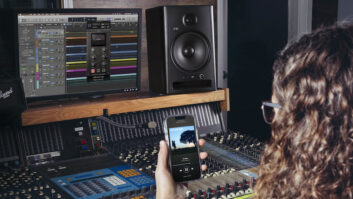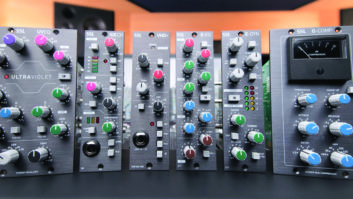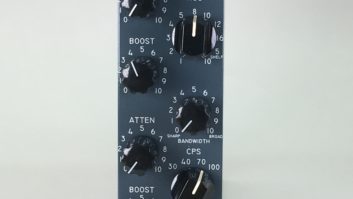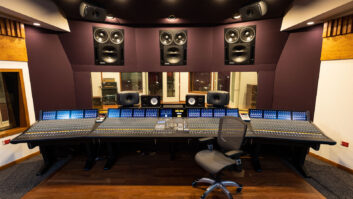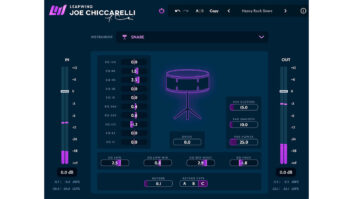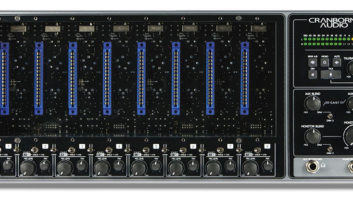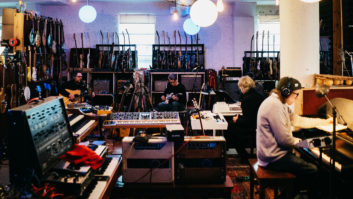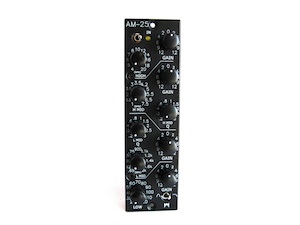
Hardware, especially portable hardware, is a hot category in audio manufacturing, and the 500 Series format has truly become a juggernaut. It seems every trade show cycle reveals at least a handful of new preamps, compressors, EQs and special-category problem solvers for the vertically inclined. The three EQs reviewed here each bring their own personality and enticements to the game. All are worth a listen, and as you’ll find, can excel across a wide range of applications.
Alta Moda AM-25 EQ
Alta Moda is a company that specializes in EQs and compressors, with the AM-25 being their new 500 Series EQ. The AM-25 fits a fair amount of functionality into its small space. There are sweepable high and low bands with ±12 dB of boost/cut between 4 kHz and 20 kHz (shelf only), and ±12 dB of boost/cut between 20 Hz and 120 Hz (shelving or bell). The LM and HM bands are fully parametric, offering ±12 dB of boost/cut between 65 Hz to 2 kHz or 1 kHz to 7.5 kHz, respectively. The unit has a hardwire bypass on a toggle with an on/off LED telling you if it’s in the signal path.
I always start an EQ review by using them around a drum kit, which reveals a lot about an equalizer. Is it versatile enough for surgical use and cutting out boxiness, and can it doctor up a kick drum? How does it sound when adding some top to the overheads? The AM-25 did a great job in most departments.
Adding gain at high frequencies on a mono overhead mic was smooth without being strident. Of course you can add too much, but it was easy to hear the line where things got out of hand. It was easy to take the boxiness out of a kick drum with the LM band. I quickly dialed in the correct amount of cut around 400 to 500 Hz and then set the Q to taste. Perfect.
When used across a mono room mic, the AM-25 had the goods. I could add top, bring out the beef in the toms and dial in just enough low end to make the room mic work well with the rest of the kit. It all sounded very musical and was the perfect processor for the job. On a kick drum, the low band was too broad when using the peak setting to bring out the thump on this particular drum, and the shelving setting added too much woof in the lowest of lows. What I usually do in these cases is jump up to the LM band, but it goes down to only 65 Hz, and even if that did work, I’d lose the band for the other use mentioned above.
Everything about the AM-25 is high-class. The unit is built like a tank using 1-percent metal film resistors, high-quality potentiometers, and gold contact switches and relays. This is a great utility EQ for acoustic guitars and everyday dressing up of hand percussion, bass guitar and everything else you can throw at it. Besides the solid build and great sound, what’s most amazing is the intro price of $299. You couldn’t make these yourself any cheaper—everyone should have two.
PRODUCT SUMMARY
Company: Alta Moda
Product: AM-25
Website:altamodaaudio.com
Price: $499 ($299 intro price)
Pros: Great-sounding EQ for a great price.
Cons: LF band peak setting too broad for some applications.
TRY THIS
When encountering a boxy-sounding kick drum, nine times out of 10 the problem lies around 400 Hz. With the AM-25’s fully parametric Low-Mid band, it’s easy to dial in the frequency at the 10 o’clock position for starters, set the Q control at 12 o’clock, then dial back the offending frequency until just the low end and attack are dominant. Adjust to taste.

Mäag Audio EQ4
Mäag Audio has been around since only 2009, but you may remember Cliff Maag as the inventor/developer of the NTI EQ3 and the Nightpro PreQ3 and EQ3D. Mäag Audio specializes in two products: the EQ4 reviewed here, and the PREQ4. Both are 500 Series modules, the latter pairing a mic preamp with an Air Band EQ. Mäag Audio also sells a software version of its EQ4 through plugin-alliance.com.
The EQ4 packs an astounding six bands of EQ into a single 500 Series unit (five fixed-frequency and one selectable). The bands are parked at Sub (10 Hz), 40 Hz, 160 Hz, 650 Hz, 2.5 kHz, and the Air Band, which is shelved and user-selectable at 2.5, 5, 10, 20, or 40 kHz. The unit is clearly labeled and easy to understand without reading the manual. Besides the adjustment knobs for gain and frequency in the Air range, there is an In/Out button with accompanying LED, plus there are LEDs for signal present and peak, which kicks in when the output reaches 23 dBu.
Although you would think that the fixed approach of the EQ4 is limiting, it’s really very usable and musical. Mäag sells it as a non-surgical EQ, which is accurate, but I found that I could get into some very fine detail work by just playing with the available bands.
I started using the unit on a mono drum overhead and immediately went for the Air Band. Wow! I reviewed the Nightpro more than a decade ago, and I immediately found the EQ4’s smooth treatment of upper frequencies comparable with the older unit. Air is the perfect word—cymbals were crisp without being brash, and I could dig down deeper into the tops of the snare and toms by kicking down the frequency choices notch by notch. I settled on an area where the cymbals and stick hits of the drums were evident and added the perfect amount.
Next, on the same track, I moved down to the 2.5 kHz band to bring out some upper-mid personality, then down to 40 Hz to boost the kick. That frequency choice was perfect for this kick. It brought out the thump without being tubby or too big in the sub range. Speaking of which, the sub range can be used to bring out some potentially large sub-harmonics or just as a filter to sculpt the bottom end, which is how I used it. I’ve got a Dangerous BAX EQ, which does that very thing for my overall mix bus output, but it’s nice to have that capability on a single track to keep you out of trouble. I also tried the EQ4 on a B3 organ, acoustic guitar and lead vocal with great results.
At $849, the Mäag EQ4 is not inexpensive, but it’s one of those essential tools you’ll grow to use and love on a regular basis.
PRODUCT SUMMARY
Company: Mäag Audio
Product: EQ4
Website:maagaudio.com
Price: $849
Pros: Air Band is revelatory. All bands are musical and useful.
Cons: Too pricey for some, especially if you need stereo.
TRY THIS
When using the EQ4 on complex material with a lot of different frequency content, use the Sub and 40Hz controls to sculpt the bottom end. By playing with boost and cut of the two bands, you can customize your low end, creating slopes that are effective for controlling the low end of a track.

SSL E-Series EQ
Back when SSL released its XRack vertical EQ and compressor units, it was a head-slapping moment for me. “Doh! Why don’t they just make 500 Series units?” Having to buy into the SSL-only XRack housing unit and power supply was something I felt kept the company’s signature units out of reach of the average Joe who couldn’t justify XRack and 500 Series. Now with the release of the 611 Series, which comprises the E-Series Dynamics and E-Series EQ, anyone can have SSL processing right alongside other popular 500 Series units, even a single unit. But you’ll probably want more.
The 4-band unit is broken into HF and LF sweepable bands and two fully parametric LMF and HMF bands. The top and bottom sections each offer a Bell/Shelf option, and there is a beefy In button at the center alongside the fabled Black button. This switches the EQ to the Black mode design developed in the 1980s, which SSL states was “the last version of the standard E Series EQ. The EQ card was called the ‘242.’” The Brown option (default) is: “The original SSL EQ fitted to all consoles prior to the summer of 1985. The EQ card was called the ‘02.’”
Although the E-Series EQ is the focus of this review (I had a pair), I also had two E-Series Dynamics units, and the pairing is lovely and worth mentioning. Both units are solid as a rock and put you in an SSL state of mind immediately. The familiar controls react as the console does and are super-clean and responsive. The pairing of the two together brings you the exact same capabilities as SSL’s high-end consoles—great EQ and dynamics in your signal path.
I used the E-Series EQ on drum overheads, toms, snare and a kick drum. My favorite application was on snare. In the LMF band, I could grab 200 to 400 Hz for the fundamental, dial in the Q, then move up to 1.5 to 2.5 kHz in the HMF and dig out the snap of the drum. Perfect! They also excelled on electric and acoustic guitars, B3 and percussion.
These EQs are addictive, as are the compressors. It was great to have the two pairs to play with across a range of tracks. The high price of entry is justified if you love that E Series sound that made so many hit records, and still does.
Kevin Becka is Mix’s Technical Editor
PRODUCT SUMMARY
Company: Solid State Logic
Product: E-Series EQ
Website:solidstatelogic.com
Price: $889
Pros: Super-clean and responsive EQ.
Cons: Brown vs. Black button results can be a challenge to hear.
TRY THIS
If you have an SSL E-Series Dynamics unit, try maxing out the threshold of the compressor (+10) and set the ratio at 1:1. Then kick the unit in/out to hear the difference. Even with zero compression, you’ll immediately get some SSL signal path love. This worked especially well on some chunky rhythm guitars, adding a nice presence in the mids that I ended up leaving in for the entire mix.
